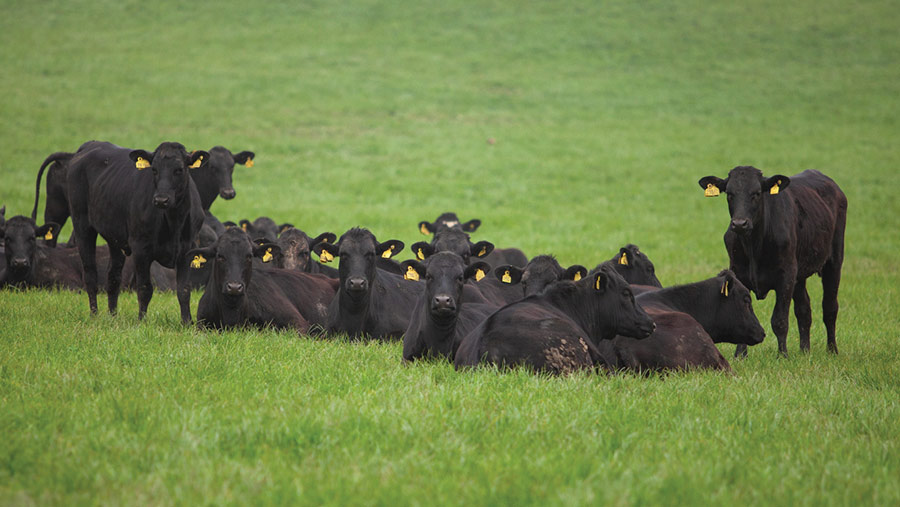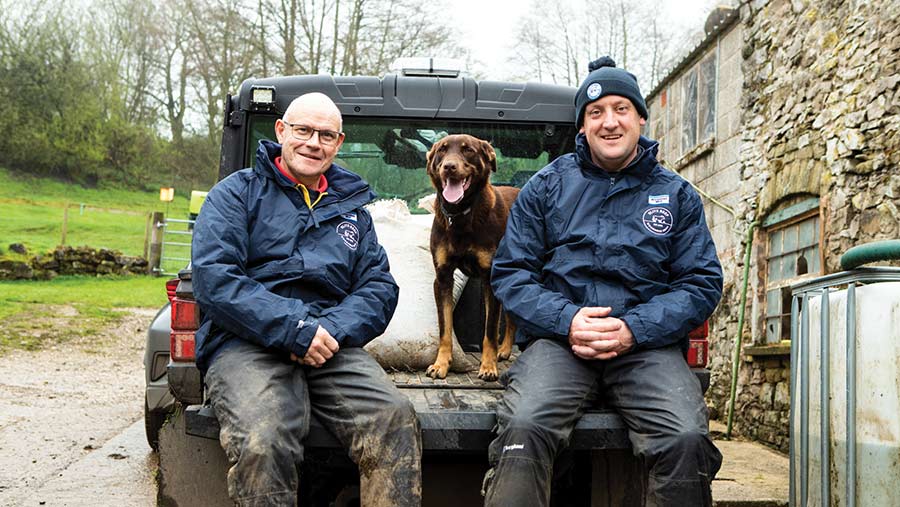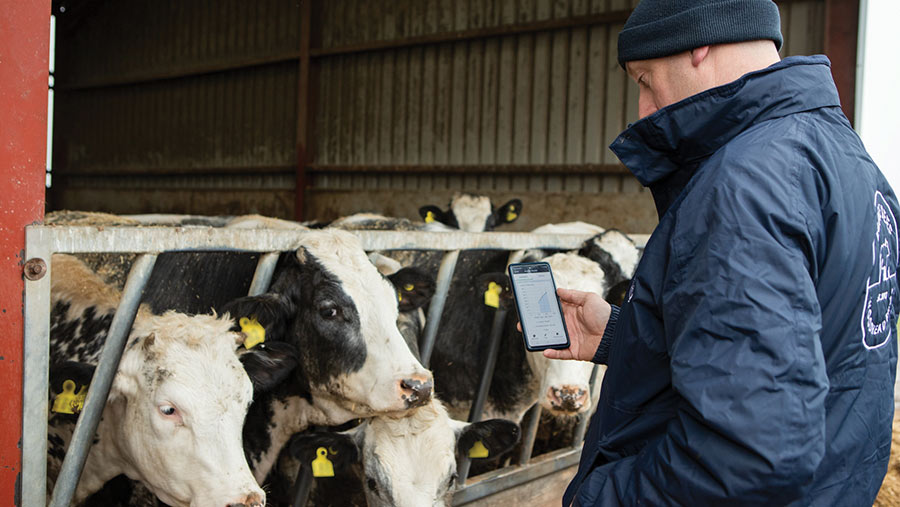How Angus-crosses beat Blues by £200 for integrated graziers
 © Morrisons
© Morrisons Costings for a Flintshire farm show native-cross cattle are beating continentals by finishing earlier and requiring less concentrate feed.
David and Mat Roberts are hoping to finish Angus-crosses exclusively after seeing them make £200 more than British Blue-cross cattle on a variable cost basis (see “Angus v Blues: How they compare”).
Even after accounting for the extra 20kg of carcass the Blue-crosses yield, the benefit is £218 a head, which David puts down to performance off forage on their farm, Ty Draw at Llanasa, near Prestatyn.
See also: Why dairy beef is set to beat arable returns
David and Mat stress they have nothing against Blue cattle; they have merely noticed that Angus-crosses thrive best in their system, finishing at about 18 months of age on high-quality, home-grown forage.
Controlled amounts of cereal are used to supplement cattle, growing them steadily on a rising plane of nutrition.
“If we had more grain and fed more intensively, I could see the Blues coming into their own,” explains Mat. “But for our system on our farm in North Wales, the native-crosses seem to net the most cash.”
Farm Facts

David and Mat Roberts © Morrisons
Ty Draw, Llanasa, Prestatyn
- 222ha of which 30ha owned and rest mostly on long-term rents
- Up to 300 dairy-beef cattle on farm in winter
- 1,400 Texel-cross ewes
- Up to 2,000 store lambs bought and finished
- Close working relationship with Morrisons
- 13ha barley, and 7ha fodder beet lifted
- 15ha of stubble turnips grown for wintering sheep
Old system
Historically, the Roberts family bought forward stores, mostly from Bryncir market. Cattle were mainly continental-cross types from suckler farms, bought to graze and finish, typically over six to nine months.
The strategy was to get them “as big as possible” – in excess of 800kg liveweight – to recoup the store price. However, the over-thirty-months rule and the falling carcass weight limit brought challenges.
David explains the cattle from the mart were good, but the system they had devised was not efficient enough.
“Falling weight and age limits meant it was difficult to make a margin after buying the large store. The initial outlay was becoming too great.”
Current system
The family has supplied Morrisons, initially through Woodheads, since 1999, and was encouraged to try Elite Beef – an integrated scheme linking beef-cross dairy calves from dairy farms to the abattoir – in 2019.
Initially, a batch of 50 Blue-cross calves were tried, and a further 100 mixed cross-bred cattle were delivered the following year.
“We still bought the forward stores in those years as we experimented with it, but have since discontinued that,” says David.
Morrisons owns the cattle in the scheme, effectively financing them until slaughter. Once all stoppages (including calf cost) are taken off the carcass value, the remainder goes to the farmer.
“We don’t pay for the cattle, but they still have to work hard,” explains Mat. “Every day they are here, they cost, so it focuses the mind.”
A critical part of the system is running cattle of each age in two groups – natives and continentals (typically Angus-crosses and Blue-crosses) so different supplementation levels can be achieved – with minimal mixing of social groups and disruption.
The system works as follows:
- Develop rumen Four-month-old calves are delivered (140kg-plus) and fed 3-4kg/head a day of a 17% crude protein grower nut with ad-lib straw. They arrive in either late March/April or August. They are given an 80-90-day transition period to develop their rumen, so they have the capacity to gain from forage.
- Grow frame Cattle are transitioned onto grass and continue to be supplemented with 2kg/head a day of grower nut. This is maintained for continental-crosses but eventually stopped for native-crosses. They graze on a three-week, three-leaf rotation for as long as possible. Typically, this is from late March to late October. Most cattle average 1.2kg of daily liveweight gain.
- Finish Cattle are moved into loose housing on mainly home-grown straw at about 450kg liveweight. George Sturla of KW Feeds draws up rations according to weight. Cattle are fed a total mixed ration using a tub mixer. The aim is to minimise bought-in feed as much as possible. The current ration is red clover silage, fodder beet and barley, all home-grown, with straw and mineral for balance. Feed is put out once in the morning and is pushed up once in the afternoon. Cattle are finished at about 650kg liveweight. This winter, they averaged about 498p/kg and were underwritten at 430p/kg.
Data recording
David and Mat have overhauled their systems to record more data in recent years. All cattle (and sheep) are fitted with electronic identification (EID) tags and monitored using Agriwebb software and weigh cells.
Calves are weighed on arrival, at spring turnout, in midsummer to coincide with a drench, and again at housing to monitor performance off grass. Once housed, they are weighed monthly.
Last summer they tried to get more from grass, with mixed results. “We tried to do a two-to-three-day rotation last summer by putting temporary fencing in, but the weather was so wet, we pulled the fencing out,” says Mat. “We couldn’t face damaging new swards.”
Angus v Blues: How they compare

Mat Roberts © Morrisons
With less barley in the total mixed ration, less concentrate at grass and two months faster finishing, the Angus-cross cattle have so far made the most cash. This is despite Blues yielding 340kg carcasses – 10-30kg more than the Anguses.
Fewer days to slaughter in the Angus pen means more flexibility with shed space. For example, store lambs or in-lamb ewes can be housed.
Carbon emission baselines by Morrisons show an Angus-only system would be 22% lower in carbon emissions intensity than the farm’s average owing to better performance off grass and closer to 100% home-grown feed. Calculations are based on Global Warming Potential 100.
Income
- Angus-cross: 316kg carcass grossed £1,451 minus cost of calf (£565) = £886
- Blue-cross: 336kg carcass grossed £1,631 minus cost of calf (£637) = £994
Feed costs
Grassland supplementation The Angus-crosses are not supplemented at grass. Blue-crosses get 2kg of a 14% crude protein finishing roll to make sure they maintain target growth rates of 1.2kg/day. At £330/t, this costs 66p a head a day, which across a 180-day summer = £118.80
Winter ration The Blue-crosses get 1kg/day more home-grown barley than the Blues in winter. At an opportunity cost of £150/t, this adds 15p a head a day, which over a 185-day winter = £27.75
Days to slaughter Most Angus-crosses were finished in October and were all gone by 13 November. Blue-crosses took two months longer, being finished in early December and January. The finishing diets costs £3 a head a day, which over 60 days = £180
Total additional feed costs for Blue-crosses £326.55
Margin after feeding
Angus-crosses made £108 less but cost £326.55 less to feed, giving a net benefit of £218 a head
